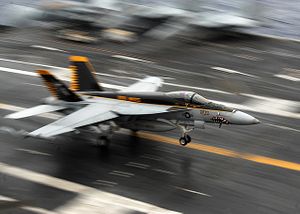Last week, in a speech delivered to a Rand Corp. audience in Washington D.C., U.S. Deputy Defense Secretary Robert Work preached his usual sermon about the slipping technological edge of the United States military and the growing danger posed by effective countermeasures to the American Way of War primarily based on precision-strike regimes (see: “The End of the American Way of War?”).
“Big state powers like Russia and China are catching up,” Work warned. “This is going to require a fundamental rethinking of how the joint force operates.” Precision-guided warfare has slowly spread among U.S. competitors across the globe and, as a consequence, can no longer be counted on as providing U.S. forces with the decisive edge to achieve victory in combat. Consequently, the American way of war has to change Work emphasized:
The first thing on any offset policy is to have a demonstrated capability to win the emerging guided munitions salvo competition. That is job number one. This demonstrated ability to win this competition will underwrite our conventional deterrence in the 21st century, and if we don’t have it, we are going to be faced with a lot of problems that we do not want to face.
As I reported before, Work believes that it is time to develop a new “third offset strategy” based on robot weapons and remote-controlled warfare on the one hand, while simultaneously relying on conventional and cheaper military hardware such as the new M109A7 Paladin (see: “The US Army’s Deadly New Gun”) – capable of firing precision munition – on the other hand.
Echoing Work’s remarks, a new report by the Center for Strategic and Budgetary Assessment (CSBA) points out that “China, Iran, and others potential adversaries have also developed air and missile defenses, electronic warfare systems, and other active countermeasures to prevent U.S. strike systems and the PGMs they launch from reaching targets. Passive countermeasures such as making weapon systems mobile and hardening or deeply burying important facilities threaten to further degrade the effectiveness of U.S. precision strikes.”
Rather than relying on expensive current-generation precision guided munitions, the CSBA report recommends the creation of new operational concepts including:
Tunneling Operations: DoD should make widespread use of inexpensive munitions to “tunnel” through air and missile defenses in future operations.
Collaborative Weapons Operations: Weapons capable of coordinating their operations after launch could help maximize target damage and compensate for weapons lost in flight.
An Emphasis on Long-range Strike Operations: To sustain its sortie capacity, the U.S. military should shift toward conducting a larger proportion of its strike operations from locations on land and at sea that are out of range of most cruise and ballistic missile threats (see: “Adios Top Gun: The End of the Fighter Jet?”).
Different uses for Short-Range Aircraft: In future salvo competitions, DoD should preferentially use fighter aircraft with limited ranges and small PGM payloads to defend forward bases and conduct counterair operations.
New Basing Approaches: DoD [Department of Defense] should pursue concepts for operating fighters from highly dispersed posture inside contested areas.
A Shift from Direct Attacks to Short-range, Standoff Strike Operations: To counter increasingly capable point defenses, even stealthy strike aircraft will need to launch attacks from standoff ranges.

































